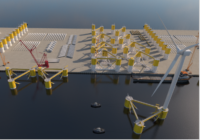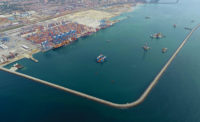Officials of the Port of Long Beach in California, the nation’s second-busiest seaport, on Aug. 20 marked substantial completion of what they say is the most sustainable container terminal in North America and one of the most technologically sophisticated in the world.
Touting the “zero-emission” Long Beach Container Terminal at Middle Harbor, port executive director Mario Cordero indirectly addressed recent media reports pointing to regional pollution caused by it and the Port of Los Angeles.
“There has been a lot of media discussion about pollution in this region,” said Cordero at the press conference. “Today, the Port of Long Beach has done something about it.”
The huge terminal features the first-ever use of automated guided vehicles at a U.S. port. Guided by transponders in the asphalt, the battery-powered vehicles transport containers from ships to storage areas and can recharge themselves.
Phase 1 was completed in April 2016 with 151 acres, allowing private terminal operator LBCT Inc. to begin operations. Phase 2 was put into operation in October 2017, expanding the facility to 191 acres. The third phase concluded in July, expanding the terminal to 300 acres with a completed container yard, on-dock rail yard, terminal administration building and a 4,200-ft-long wharf. In a separate component, the North Gate Expansion is expected to complete by 2025, expanding the terminal to 303 acres.
The $1.5-billion project is the main feature of the decade-long Middle Harbor Redevelopment Program, which launched in 2011 and involved dredging wider and deeper channels, wharf construction, backlands development, shore-to-ship power, expansion of on-dock railyard facilities, and a 4,200-ft concrete pile-supported wharf with three deepwater berths that support 18 shore-to-ship gantry cranes.
The expansion increases terminal capacity by 1 million Twenty-foot Equivalent Unit (TEUs) to 3.5 million TEUs a year, said Anthony Otto, LBCT Inc. CEO. TEUs are the typical shipping containers that come on and off ships.
“Most important is that Long Beach Container Terminal is the first near-zero emissions terminal in North America,” he said. “The new model established here … proves that the industry can [provide services] in a more sustainable way.”
An LA Times editorial about the port emphasized the lack of progress in incentivizing truckers to replace their diesel trucks with cleaner models. Port officials emphasized the terminal will facilitate faster truck turnaround times, reducing emissions. Also, the port is planning to expand on-dock rail capacity by 11% to 35%, further decreasing truck dependence. One double-stacked train is the equivalent of 75 trucks, according to the port.
The $870-million, 171-acre-rail facility, slated for construction in 2023, will be a full-service staging area for storing, sorting and assembling trains up to 10,000 ft long. The first arrival, departure and storage tracks are expected to be operational in 2024. Additional tracks are due to come online in 2030, and the entire project is scheduled to be completed in 2032.
Engineers' "Disneyland"
With everything from rail to wharves and dredging, to buildings, solar car ports and substations, the Middle Harbor redevelopment "was like Disneyland for engineers," says John Chun, the port's director of engineering design. "Everything that we can electrify, we have."
Over the 10 years, construction had to coexist with existing terminal operations while engineers needed to keep an eye on rapidly evolving trends. "During wharf design and throughout the course of master planning since 2006, the design of vessels was changing significantly," says Thomas Baldwin, director of project management. "It started with 8,000-TEU capacity. In a couple of years, we were talking about 18,000 TEUs." Paving systems needed to handle automated vehicles that when loaded could weigh up to 60 tons.
Moreover, demand for crane capacity got bigger, which engineers also had to incorporate into design, says Monique LeBrun, senior program manager. She notes that the terminal, with an ultimate capacity of 3.5 million annual TEUs, would be the sixth busiest port in the U.S. "It has the largest and most advanced ship-to-shore cranes in the world. Everything had to get larger," she says. Wharf design, which already is challenging because of seismic considerations, included octagonal concrete piles 125 to 135 ft long to handle the capacity.
The work entailed demolishing an old wharf supported on timber piles, to be replaced by the newe 4,200-ft-long wharf. "We tried to extract as many of those piles as possible," says Baldwin. Sometimes they snapped off, or created voids. Subsidence caused by existing oil field operations was addressed with landfill and having oil extractors compensate for voids by adding water.
The new intermodal rail yard includes 70,000 track ft. "There are 12 tracks, and each is almost a mile long," says Baldwin. "There are four storage tracks, and eight working tracks. Five dual cantilevered gantry cranes with room for a sixth. It's one of most modern railyards ever built, with 1.1 million-TEU capacity."





Post a comment to this article
Report Abusive Comment